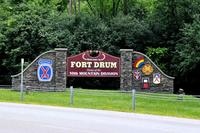Coast Guard Gunner's Mate Frank DeVita crawled over the bodies of the dead who lay in the blood and puke covering the deck of the Higgins boat on Omaha Beach to save the landing craft during the first wave of D-Day landings on June 6, 1944.
DeVita's main job as part of the landing craft's crew was to raise and lower the front ramp on orders of the coxswain, or boat driver, to allow more than 30 troops from the 1st Infantry Division, the "Big Red One," to storm ashore, but the German MG-42 machine guns took their toll.
In oral histories and in a Coast Guard interview, DeVita, of Brooklyn, New York, spoke of the numbing fear that the boat crews had to overcome on D-Day, the beginning of the Allied invasion of France that became a turning point in the war against Nazi Germany during World War II. Friday marks the 81st anniversary of the massive military operation.
Read Next: Air Force Special Operations Command Names New Enlisted Leader as Predecessor Faces Investigation
As soon as DeVita lowered the boat's ramp, "about 15 or 16 GIs died immediately" from the German fire, he said. "The first guy who got hit -- ripped his stomach open. Another guy two feet away was hit in the head, took his helmet off."
Now, the coxswain was screaming at him to get the ramp back up to allow the boat to back off the beach, but the ramp was stuck.
"I didn't know what to do. The ramp was in the front and I'm in the back. I can't see it from where I am because of the dead and wounded in front of me. I had to crawl over them to get to the ramp. And while I'm crawling, I'm crying. I'm saying to these kids, 'I'm sorry, please excuse me. I have no other alternative,'" DeVita said.
"When I got closer, I realized that two dead soldiers were on the ramp, holding it down. They never got off the boat. I tried lifting them up, but I couldn't. I weighed 125 pounds. Another guy came to help and, inch by inch, we pulled them into the boat," he said.
DeVita then tried to comfort one of the wounded. "He was crying 'help me, help me,' but I had nothing in my kit to help him." He started reciting the Lord's Prayer but never finished. "I knew he was gonna die," DeVita said. "I wanted him to know that he was not alone, and I reached down and touched his hand. And he died; he died."
His boat returned to the beach 14 more times to deliver troops and supplies after the initial landing in the first-wave assault. DeVita also noted that on trips to the attack transport USS Samuel Chase his boat had brought back a total of 308 bodies of U.S. troops who had been killed in action.
The role played by DeVita and the other Coast Guard personnel who crewed the Higgins boats was critical to the success of the D-Day landings in gaining a foothold in France to begin the liberation of Europe from the Nazis.
Gen. Dwight Eisenhower, the supreme Allied commander, often paid tribute to the Coasties and the Higgins boats by referring to Andrew Jackson Higgins, the New Orleans industrialist and designer of the Higgins boats, as "the man who won the war for us."
The expertise of the Higgins crews was such that many of the Coasties, including DeVita, were transferred to the Pacific after the Nazi surrender and participated in the landings on Iwo Jima and Okinawa.
Coast Guardsmen manned 99 warships and large landing vessels for Operation Neptune, the naval component of D-Day involving more than 6,900 ships and landing craft, including about 1,500 Higgins boats, according to a piece on the Coast Guard website titled "The U.S. Coast Guard at Normandy." A total of 18 Coast Guardsmen were killed and 38 were wounded in the course of the fighting on D-Day.
The flat-bottom Higgins boat itself was slightly more than 36 feet in length with a beam of just under 11 feet and was powered by a 225-horsepower Gray Marine 6-71 diesel engine at a maximum speed of 12 knots in calm seas. The sides and rear of the landing craft were made of plywood and offered little protection against enemy fire.
The vulnerability of the Higgins boats was not lost on Harold Schultze, who was the coxswain of a boat operating off the transport USS Bayfield on D-Day with the task of putting troops ashore on Utah Beach.
"The German fire was extremely heavy," Schultze told the Lubbock Avalanche-Journal in 2019. "As the driver, I would try to get to the beach and the bullets were hitting all around you, the ramp and everywhere. It was hard watching those young men drop off into the water. They had over 50-pound backpacks and were trying to hold their rifles over their heads all while being under heavy fire. Often, they couldn't get their footing, and many of them drowned before even getting to the beach. These were some of the bravest men I have ever seen."
The hardest part of his repeated trips to the beach on D-Day, Schultze said, was removing "the dog tags off of the dead soldiers floating in the water. That got to me. You eventually became numb to the sights and had to carry on, but you could never forget."
Related: What Ike Remembered When Returning to the Beaches of Normandy 20 Years After D-Day













